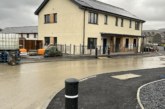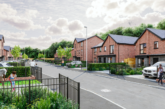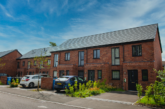Taking a flexible and collaborative approach to regeneration. LABM finds out how Lovell is making a difference to people’s lives in a new community in London.
Sustained population growth and fast rising land values are bringing a new set of considerations into the way local authorities and housing associations decide how to improve and provide new affordable housing across many of London’s social housing estates.
In the last 10 years around 50 former council estates of varying sizes and complexity across the London boroughs have been granted planning permission for substantial regeneration. A project that typifies the ambitions and vision in the London Boroughs has been Lovell Partnerships’ £398m 13-year regeneration programme in Woolwich.
In 2013, Lovell was appointed by Royal Borough of Greenwich for its ‘flexibility and collaborative’ approach to long-term partnership. This dedicated programme of investment, partnership working and housebuilding will deliver over 1,500 new homes across two former council estates selected by the council for regeneration.
The first, the Connaught Estate in Woolwich, was built by London County Council in the 1960s as part of a slum clearance programme, heralding a new era in mass social housing. It was the first estate in London to use a system-built method of prefabricated concrete slabs to quickly and efficiently address the area’s housing shortages.
However, the estate soon deteriorated and became blighted by high crime rates, drug use and anti-social behaviour. The blocks’ communal stairways were unprotected by security doors, creating an intimidating environment for residents, while the flats themselves were cramped, noisy, damp and expensive to heat.

Transformational project
The first phase of this project is transforming this predominantly social housing area into a vibrant mixed community of one-, two- and three-bedroom apartments in blocks up to 10 storeys high, as well as three- and four-bedroom houses. Over a third of the homes are affordable housing for rent or shared ownership, with the rest for open market sale.
Over the last six years, this major regeneration scheme for Woolwich has already delivered more than 600 open market and affordable homes to the borough whilst also driving job creation, apprenticeships and economic growth.
Lovell’s vision for Trinity Walk was to create high-quality communities, with a strong sense of place, where people choose to live and stay. The company’s approach was to ensure the new homes enhance existing connections to local communities, shared facilities, health, transport links and other infrastructure.
To ensure Trinity Walk met local needs, Lovell worked with the council and the local residents to carry out extensive community consultations as well as a number of public exhibitions where residents, businesses and other stakeholders could discuss the proposals. Lovell used BIM software to give 3D views of the new estates to show how the completed schemes will look.
From the feedback, street scenes at Trinity Walk were carefully considered to enhance the sense of community with a public realm at its heart and attractive tree-lined streets connecting the new homes with Woolwich town centre. Apartments with balconies now enjoy views over the surrounding open space and towards the River Thames while quiet podium courtyards and walled gardens with trees and shrubs provide a sheltered backdrop to outdoor private and shared spaces.

Employment and training opportunities
As part of its commitment to leaving lasting community benefits, Lovell also made sure the scheme provided major job and training opportunities locally, including up to 177 apprenticeships over the duration of the project. Lovell attended a job fair organised by Woolwich Jobcentre Plus, with over 70 jobseekers visiting its stand for advice on the opportunities available as part of the project.
Lovell has also worked with The Royal Borough of Greenwich to develop an extensive employment and skills plan to improve the economic position of residents within the borough, with all vacancies advertised through Greenwich Local Labour and Business. Its housing partner, PA Housing, is working with the community to deliver a Volunteer Training Programme, which gives opportunities to tenants.
An open evening was organised to encourage local women to consider a career in construction. The event included a tour of the site, a presentation and the chance to meet women already working at Lovell. As part of its commitment to establishing lasting benefits for local neighbourhoods, Lovell created a £150,000 Community Trust to fund community groups and projects.

Spirit of collaboration
The council have worked in collaboration with Lovell with the exciting project from the start. Leader of Royal Borough of Greenwich, Danny Thorpe, said: “This development sits right at the heart of Woolwich and has allowed many young people and families to remain in this part of London. I am also pleased that so many local people are being employed here on the site — a project with longevity and the local community at its heart.”
Stuart Gibbons, Lovell Managing Director, London and Southern regions, adds: “The Lovell vision is to create high-quality schemes with a strong sense of place and community. Our approach will ensure the new homes enhance existing connections to local communities, shared facilities, health, transport links and other infrastructure.
“Our objective is to regenerate places and make them better by building affordable, quality housing across all tenures. That’s very much the foundation of our business model over the last 50 years and our strategy for the foreseeable future.”
With thanks to Lovell for preparing this article.









